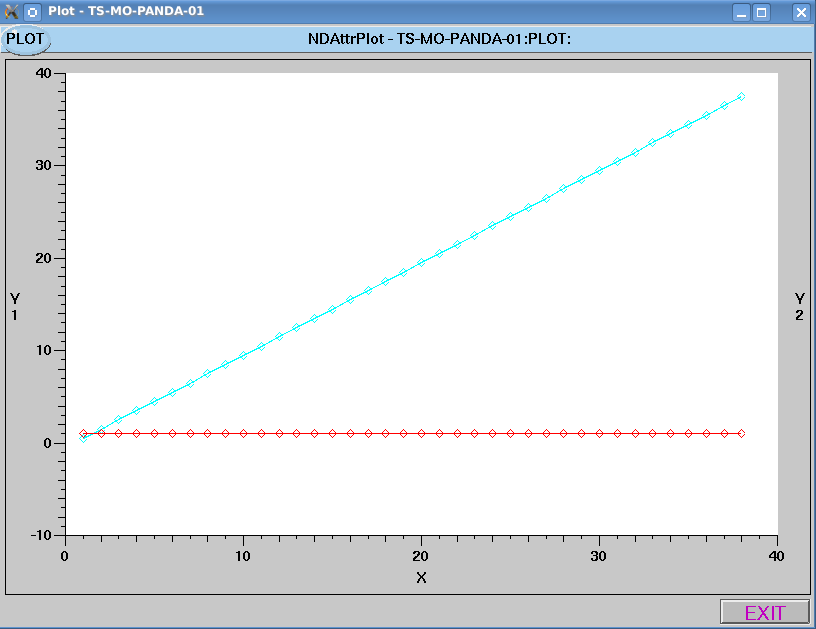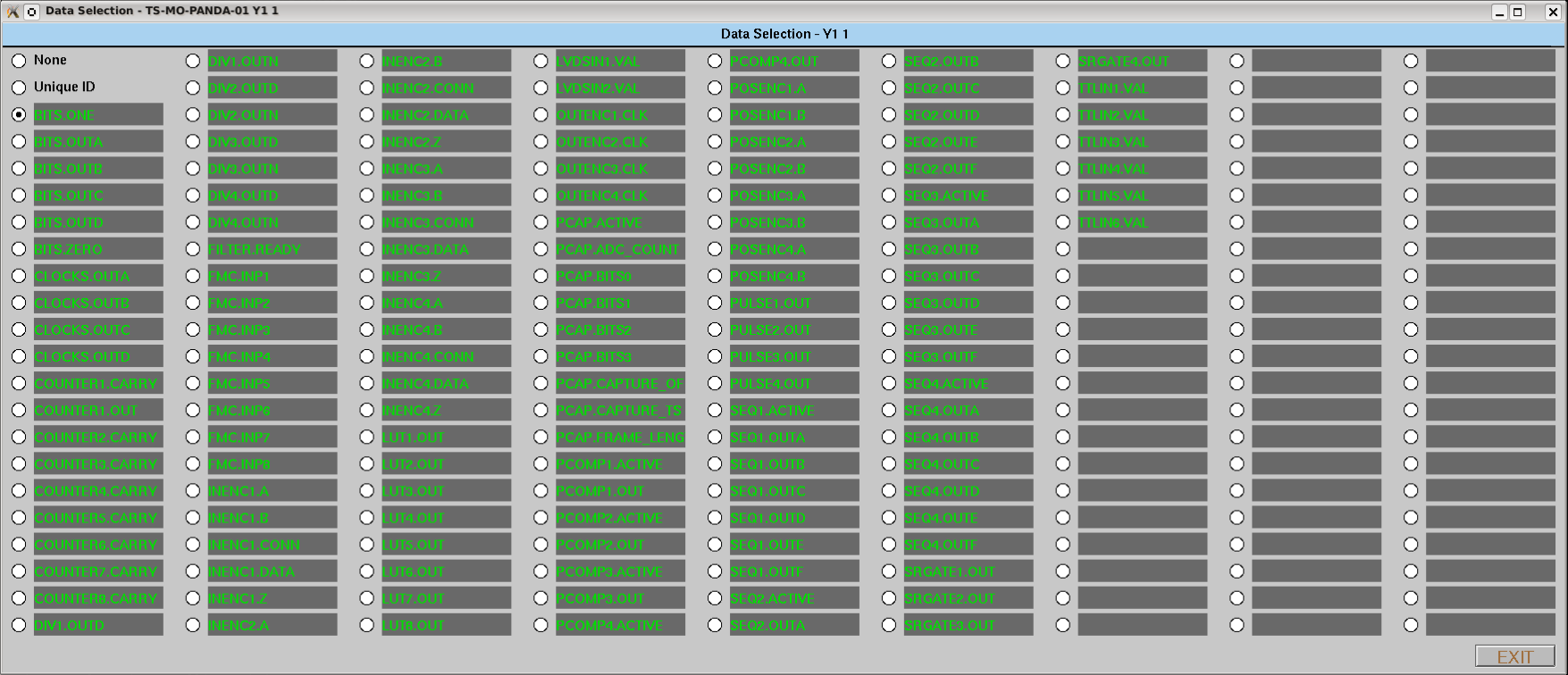NDPluginAttrPlot
- author:
Bla Kranjc, Cosylab
Overview
This plugin is aimed for drivers that expose data as NDAttributes. The main use case for the plugin is to retrieve NDAttribute values, cache them and expose them as a waveform. This enables easy plotting of real-time values of the attributes in OPIs. Graphical representation of the use case is depicted in Figure 1.
The plugin is similar to the NDPluginAttribute, the differences are described in the section Comparison to NDPluginAttribute. All configuration options and instructions are contained in the section Configuration. A real world example of the plugin usage and EDM GUI can be found in the section Screenshots. Details of added parameters for this plugin and other development details can be found in the section Developer Notes.

Typical use case that can make use of the NDPluginAttrPlot.
The plugin is initialized when the first NDArray is passed to it and
reinitialized whenever the $(P)$(R)Reset is processed or the
unique ID of the received NDArray has decreased. The names of the
attributes that are saved are not part of the plugin configuration but
are extracted from the NDArray. Unique ID of the NDArray is always
tracked as if it was an attribute. During initialization the list of
NDAttributes in the NDAttributeList of the NDArray is traversed and a
preconfigured number of NDAttribute names and their values are saved on
the first come first served basis.
Note
Please note that only numerical
attributes are supported by the plugin. String attributes are skipped
and all numerical attribute values are converted to double.
The values are saved internally in the plugin in a circular buffer. The length of this buffer is configured at the plugin load and cannot be configured during runtime. Also all attributes use the same value for the circular buffer length.
The names of the NDAttributes that are saved by the plugin are exposed
to the EPICS layer in $(P)$(R)Attr$(ATTR_IND) records. To reduce
the strain on the channel access interface not all circular buffers are
exposed at all times, but only a preconfigured number of waveform
records are available. The records are named
$(P)$(R)$(AXIS):Data$(DATA_IND). Additional macro AXIS is
added to clearly name the plot’s X or Y axis if required. As the main
purpose of the plugin is live plotting the data records are processed
periodically with 1 Hz and is not tied to the acquisition period. The
data that is exposed to the waveforms is selected by writing the index
(ATTR_IND) of desired attribute to the
$(P)$(R)$(AXIS):DataSelect$(DATA_IND) record. Magic numbers are
used for selection of Unique ID field (value of -1) and a selection of
“None” - array of all zeros (value of -2). The readback of index and the
name of the attribute name are then exposed on
$(P)$(R)$(AXIS):DataSelect$(DATA_IND)_RBV and
$(P)$(R)$(AXIS):DataLabel$(DATA_IND) respectively. Current length
of the internal circular buffer is provided to the user via
$(P)$(R)NPts record.
Additional notes about this plugin:
If the value for an attribute that is being saved is not present in the NDArray a 0 is written for that value in the circular buffer;
Exposed attributes are preserved among re-initializations if possible.
Comparison to NDPluginAttribute
NDPluginAttrPlot is different from NDPluginAttribute in the following ways:
Attributes are not selected by name but rather a list of first N attributes is extracted from the first NDArray of an acquisition;
Circular buffer is used for attribute values;
The attribute values are written to the waveforms periodically (1Hz), decoupled from the callbacks;
Only exposes raw attribute values;
All numerical attributes are supported but the values are converted to
double.
Configuration
The NDPluginAttribute plugin is created with the NDAttrConfigure command, either from C/C++ or from the EPICS IOC shell. The prototype of its constructor is
NDPluginAttrPlot(const char * portName, int n_attributes, int cache_size, int n_data_blocks,
const char * NDArrayPort, int NDArrayAddr, int queueSize, int blockingCallbacks, int priority, int stackSize)
Parameters NDArrayPort, NDArrayAddr, portName,
queueSize, blockingCallbacks, priority and stackSize are
arguments common to all plugins.
Configuration of the driver instance is tightly coupled to instantiation of EPICS dbs and macro substitution. Unfortunately this tight coupling must be managed manually
n_attributesdefines the maximum number of attributes that are saved by the driver.n_attributesinstances ofNDAttrPlotAttr.templatemust be loaded withATTR_INDmacro ranging from 0 ton_attributes - 1.n_data_blocksdefines the number of data exposing waveforms.n_data_blocksinstances ofNDAttrPlotData.templatemust be loaded withDATA_ADDRmacro ranging from 0 ton_data_blocks - 1.cache_sizedefines the max length of circular buffers that are used to save values of the attributes. The macroN_CACHEinNDAttrPlotData.templatemust be set to the same value.
For further details please refer to the documentation in the source file
NDPluginAttrPlot.cpp.
Screenshots

Main plugin screen of the NDPluginAttrPlot plugin

Plot screen showing two parameters plotted against their Unique ID

Attributes to plot are selected on the select screen
Developer Notes
NDPluginAttrPlot inherits from NDPluginDriver. The NDPluginAttribute class documentation describes this class in detail.
NDPluginAttrPlot defines the following parameters. It also implements all of the standard plugin parameters from NDPluginDriver.
Parameter Definitions in `NDPluginAttrPlot.h` and EPICS Record Definitions in `NDAttrPlot.template` |
|||||
|---|---|---|---|---|---|
drvInfo string |
asyn interface |
Access |
Description |
EPICS record name |
EPICS record type |
AP_Reset |
asynInt32 |
w |
Write to this record forces reinitialization of the plugin on the next callback. |
$(P)$(R)Reset |
ao |
AP_NPts |
asynInt32 |
r |
Number of saved cached points. |
$(P)$(R)NPts |
ai |
AP_Attribute |
asynOctetRead |
r |
Attribute name. |
$(P)$(R)Attr$(ATTR_IND) |
stringin |
AP_Data |
asynFloat64ArrayIn |
r |
Exposed data for $(DATA_ADDR). |
$(P)$(R)$(AXIS):Data$(DATA_IND) |
waveform |
AP_DataSelect |
asynInt32 |
r/w |
Index of selected attribute for $(DATA_ADDR). |
$(P)$(R)$(AXIS):DataSelect$(DATA_IND), $(P)$(R)$(AXIS):DataSelect$(DATA_IND)_RBV |
ao, ai |
AP_DataLabel |
asynOctetRead |
r |
Attribute name for $(DATA_ADDR). |
$(P)$(R)$(AXIS):DataLabel$(DATA_IND) |
stringin |
If the array data contains more than 16K bytes then in order for EPICS
clients to the environment variable EPICS_CA_MAX_ARRAY_BYTES on both the
EPICS IOC computer and EPICS client computer must be set to a value at
least as large as the array size in bytes.